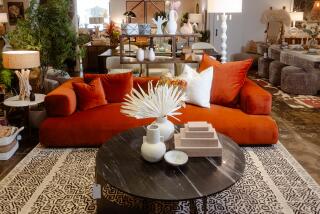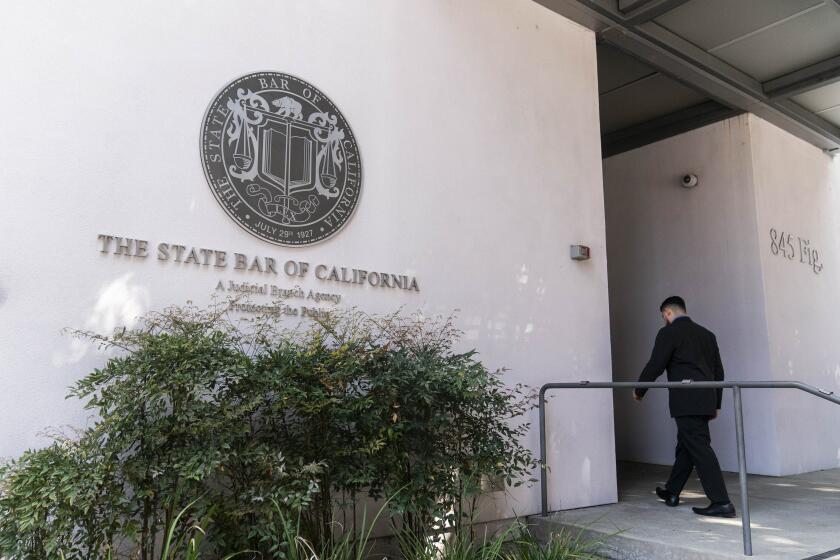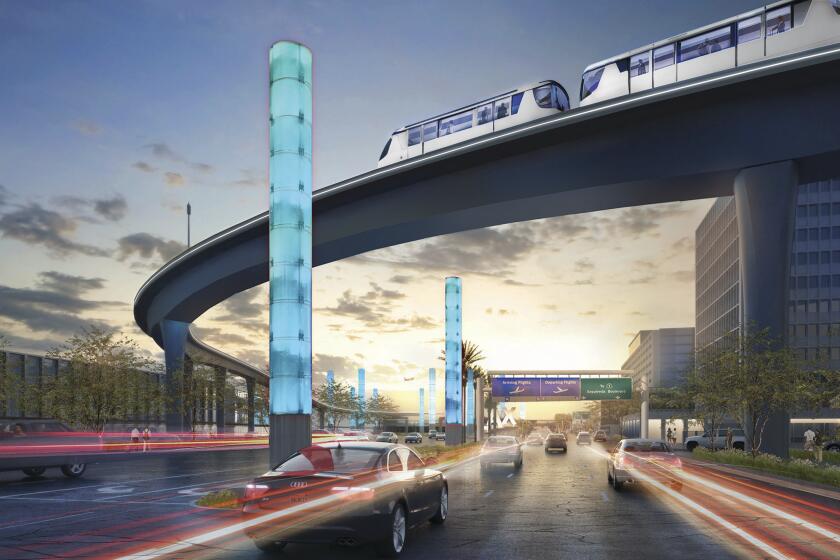Not Just an Old Wreck : Hupmobile Agency Was Once Showplace
- Share via
LONG BEACH — Once upon a time, when the city was swimming in oil and Bixby Knolls was nothing but a bean ranch, Long Beach fell in love with the Hupmobile. The car had a funny name, but it also had a sliding gearbox and some fancy curves. “She was a classy, popular thing,” recalled Bill Harris, former president of the Long Beach Historical Society.
All that remains of this short but sweet fling is a run-down garage full of wrecked cars at the corner of East Anaheim Street and Linden Avenue. It’s a sorry state of affairs for a building that once showcased one of the sleekest models of the Roaring ‘20s.
The Long Beach City Council rescued the former Hupmobile dealership from obscurity recently when it declared the 1928 showroom a historical landmark. The building’s owners, Chanmony and Siamary Nou, proposed the designation last year because they thought it would help them sell the place, which is on the market for $1.29 million.
After learning that the designation makes it tougher for a developer to demolish the building, the Nous changed their minds. But city officials, realizing the building is one of the finest Art Deco structures still standing in Southern California, proceeded with plans to have it declared a landmark, which allows the city to delay demolition or significant changes for up to a year while suitable alternatives are sought.
“Most of the older buildings in the city have been destroyed. This is one of the best examples of Art Deco we have left, and it has an interesting history,” said Ruthann Lehrer, the city’s historic preservation officer.
The Nous have changed the name of their business from Care & Quality Auto to Landmark Motors, but said they still hope to sell the building.
City officials call the building a monument not only to the Hupmobile and to Art Deco architecture, but to one of the most glorious eras of oil and automobiles in Long Beach.
In those heady days of the ‘20s and ‘30s, dealers paraded their newest models up and down Pine Avenue, and men raced their new contraptions along the beach. The discovery of oil created another kind of joy ride for city residents, who rode an unprecedented period of growth and wealth well into the ‘30s. Even middle-class families in Long Beach could suddenly afford to buy a car from the score of automobile dealerships that popped up on East Anaheim Street.
Today, many of the stores along Anaheim are boarded up. Most of the car dealerships have fled the run-down neighborhood for automobile malls. The Hupmobile dealership folded decades ago, and time and crime have taken a toll on the auto-body shop that is there now. The Nous have pounded plywood over broken windows and removed graffiti from the walls. But the cast stone reliefs of geometric and floral designs decorating the building are intact. So is the interior showroom, a large open space with a terra-cotta tile floor, a mezzanine, friezes, an elegant staircase with wrought-iron banisters, and the original Art Deco chandeliers.
The showroom was conceived by Lemuel A. Hancock, a smooth-talking young man with a red mustache and a yen for risky undertakings. “Lem” Hancock moved to California in 1912 with his brothers and father, a Virginia tobacco processor. He dabbled in cattle ranching in Montana before founding the Hancock Oil Co. in Long Beach in 1922 with his oldest brother, John Walker Hancock. After a few years--nobody in the Hancock family can remember exactly how many--Lem grew restless and left to try his hand at a string of other business adventures, including selling Hupmobiles.
His relatives went on to make millions in the oil business. “I don’t like to think about it,” sighed his 96-year-old widow, Willa Mae.
In 1928, Lem built his Hupmobile dealership, which became the talk of town.
Hancock hired one of the finest architect firms, Schilling & Schilling, to design what became a daring experiment in what was then called Arte Moderne. The avant-garde building featured carvings of rams’ heads with garlands hanging from their horns--an image borrowed from Michelangelo’s motifs at the Palazzo Farnese in Rome. There were also decorative motifs patterned after the Egyptian lotus, and Persian and Greek rosettes.
Nothing was too good for the Hupmobile.
Townspeople gawked at what the local paper called the new “Hupp Home.” “This handsome, imposing structure is to be occupied by one of the fastest growing and most successful automobile dealerships in Long Beach,” gushed the Long Beach Press-Telegram.
The Hancock Motors Building opened with a glittering party on the evening of Oct. 27, 1928. City dignitaries read speeches from the balconies. Guests danced under the new showroom’s glass chandeliers. Lem’s 11-year-old daughter, Dorothy, passed out candy and balloons. “It was a big and elegant party,” she recalled recently. “To give it atmosphere, all of the salesmen were dressed in tuxedos. There were flowers and spotlights on the cars. People got little packages of gifts to take care of their cars. Dad hired a man in top hat and tails to greet guests at the door. You sure wouldn’t think of doing all that anymore.”
The car was considered one of the hottest cars of the decade. Even the bootleggers liked them and asked Hancock’s mechanics to strap tanks for booze to the bottom of their Hupmobiles, according to Jim Hancock, Lem’s son. (Lem refused.)
Produced from 1908-40, the Hupmobile ranked about 10th in sales during the ‘20s, despite its price and strange name. By the late 1920s, it cost close to $1,000, triple that of Henry Ford’s assembly-line Model T. It was named after Robert and Louis Hupp, two brothers who founded the company in Detroit in 1908.
But the Hupp brothers were among the first to experiment with aerodynamics. In the late 1920s, the Hupmobile featured sleek, streamlined shapes, aluminum parts, a sliding gearbox, elongated headlights and a sloping radiator. “It wasn’t just a box on wheels,” said Glen Stevens, a longtime resident who collects antique automobiles.
Across the street from the new Hupmobile dealership was Glenn A. Thomas Motors. Thomas sold Studebakers, and, later, Dodges. His son, David, polished his dad’s cars for a nickel an hour. David doesn’t recall much about his father’s competitor except its name. “It was always a joke,’ ” Thomas confessed. “We giggled about it.”
On Sundays, owners would race their new cars on the beach.
“There were these guys racing Hupmobiles and Dodges and Oldsmobiles for miles,” David Thomas said. “My daddy never could beat this one Buick. It made him so mad, he used to practice when he had spare time and the tide was low. Finally he beat that Buick.”
But his favorite time, Thomas recalled, was when the freight train would roll in with a new shipment of cars from the Midwest. Scores of townspeople would gather to watch them unload, Thomas said. Up to eight cars were propped on blocks of wood in each car, their noses to the ceiling. “God, it was exciting to watch,” Thomas said.
Every fall, Lem Hancock, Glenn Thomas and the other dealers along Anaheim drove the new season’s models up and down Pine Avenue to display them, according to Harris, the former president of the Long Beach Historical Society.
Harris recalls the Hupmobile with fondness. He used to ride a shiny green Hupmobile owned by his pal from Long Beach, Spike Jones. Harris and Jones played such tunes as “Let Me Call You Sweetheart” and “Alice Blue Gown” for the local clubs. They tossed their instruments in the back seat and pushed back the top. “Seemed like it was always good weather,” Harris said.
Jones went on to achieve fame as a musician who poked fun at Adolf Hitler. Lem Hancock sold his dealership in 1936. Hupmobile production stopped in 1940, its sales stunted by the Depression and competition from assembly-line cars.
Lem Hancock went on to other ventures in real estate and gold mining. He died in 1970, at age 80.
And, until recently, the old Hancock Motors Building was forgotten.
More to Read
Sign up for Essential California
The most important California stories and recommendations in your inbox every morning.
You may occasionally receive promotional content from the Los Angeles Times.










